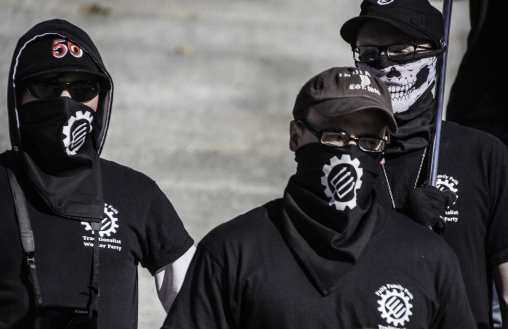Nazi Sympathizer Profiled by New York Times Is Fired From His Job
The piece triggered widespread outrage, with some critics blasting a casual and normalizing approach to the man's beliefs. Members of the Traditionalist Worker Party, which Tony Hovater, the subject of a New York Times profile, helped found. (Traditionalist Worker Party Tennessee)
Members of the Traditionalist Worker Party, which Tony Hovater, the subject of a New York Times profile, helped found. (Traditionalist Worker Party Tennessee)
A white supremacist featured in a Nov. 25 New York Times article has been fired from his job following widespread outrage against the newspaper. Critics objected to the casual tone of the piece, which presented its subject, Tony Hovater, a 29-year-old man from Ohio, as a regular guy—what the article called “the Nazi sympathizer next door.”
The profile begins:
Tony and Maria Hovater were married this fall. They registered at Target. On their list was a muffin pan, a four-drawer dresser and a pineapple slicer.
Ms. Hovater, 25, was worried about Antifa bashing up the ceremony. Weddings are hard enough to plan for when your fiancé is not an avowed white nationalist.
But Mr. Hovater, in the days leading up to the wedding, was somewhat less anxious. There are times when it can feel toxic to openly identify as a far-right extremist in the Ohio of 2017. But not always. He said the election of President Trump helped open a space for people like him, demonstrating that it is not the end of the world to be attacked as the bigot he surely is: “You can just say, ‘Yeah, so?’ And move on.”
Critics accused the paper of normalizing Hovater’s views by referring to him as “polite and low-key at a time the old boundaries of accepted political activity can seem alarmingly in flux,” and a man whose “Midwestern manners would please anyone’s mother.”
Vox continues:
The problem with the Times story isn’t that it’s about a modern-day Nazi. It’s that it doesn’t offer any insight into modern-day Nazis. Readers are, presumably, supposed to respond with shock upon learning that Nazis also bake muffins, own pets, watch sitcoms. But this is an old point, and it can be made with starker examples. Adolf Hitler was a vegetarian, a painter, a lover of musicals, a talented mimic. It is childish, this late in human history, to be surprised that evil people are also people.
Richard Fausset, the reporter on the story, published an accompanying reflection that is, in many ways, more interesting than the article itself. In it, he admits that there was “a hole at the heart” of his piece, an absence where there should have been an answer. Fausset wanted to explain how Hovater became a Nazi, to find the origin of his divergence from the American mainstream, but all he found was a normal-seeming Ohioan who happened to be a virulent racist and anti-Semite. “I beat myself up about all of this for a while,” he writes, “until I decided that the unfilled hole would have to serve as both feature and defect.”
On Wednesday, the New York Times reported that Hovater, his wife, Maria, and her brother—who had all worked at 571 Grill and Draft House in a suburb of Dayton—had been fired from their jobs at the restaurant. Though the Times did not name Hovater’s workplace in the original profile, he had identified himself as a welder, and readers were able to track down the family’s employment information online. Some called the restaurant or left “threatening and intimidating” messages online, according to a statement by the restaurant released Wednesday.
1/ The NYTimes is densely defending their article by claiming it was intended to shed light on the normalcy of racism in American society.
I agree this is a worthy topic of discussion.
So, let’s talk about all the things the Times could have *actually* achieved this. . . . pic.twitter.com/9ZsHMxsz8p
— Mangy Jay (@magi_jay) November 26, 2017
“The Times could have asked Hovater what he meant when he said ‘things have gotten bad.’ Or, perhaps, what he meant by ‘normal people,’ ” she wrote. She also criticized the paper for not writing about the Traditionalist Worker Party, which has been classified as a hate group by such organizations as the Southern Poverty Law Center. She said the reporter should have challenged Hovater to defend his position. “Otherwise you are just giving a racist an unchallenged platform,” she said.
Independent journalism is under threat and overshadowed by heavily funded mainstream media.
You can help level the playing field. Become a member.
Your tax-deductible contribution keeps us digging beneath the headlines to give you thought-provoking, investigative reporting and analysis that unearths what's really happening- without compromise.
Give today to support our courageous, independent journalists.






You need to be a supporter to comment.
There are currently no responses to this article.
Be the first to respond.